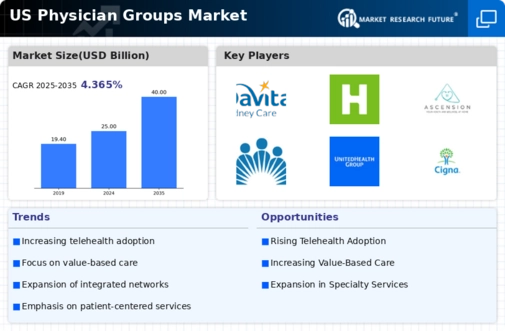-
EXECUTIVE SUMMARY
-
MARKET INTRODUCTION
-
Definition
-
Scope of the Study
- Research Objective
- Assumptions
- Limitations
-
RESEARCH METHODOLOGY
-
Overview
-
Data Mining
-
Secondary Research
-
Primary Research
- Primary Interviews and Information Gathering Process
- Breakdown of Primary Respondents
-
Forecasting Model
-
Market Size Estimation
- Bottom-Up Approach
- Top-Down Approach
-
Data Triangulation
-
Validation
-
MARKET DYNAMICS
-
Overview
-
Drivers
-
Restraints
-
Opportunities
-
MARKET FACTOR ANALYSIS
-
Value Chain Analysis
-
Porter’s Five Forces Analysis
- Bargaining Power of Suppliers
- Bargaining Power of Buyers
- Threat of New Entrants
- Threat of Substitutes
- Intensity of Rivalry
-
COVID-19 Impact Analysis
- Market Impact Analysis
- Regional Impact
- Opportunity and Threat Analysis
-
US PHYSICIAN GROUPS MARKET, BY NUMBER OF PHYSICIANS
-
Overview
-
2 to 10
-
11 to 24
-
25 to 50
-
More than 50
-
US PHYSICIAN GROUPS MARKET, BY OWNERSHIP
-
Overview
-
Physician-Owned
-
Hospital-Owned
-
Others
-
US PHYSICIAN GROUPS MARKET, BY SPECIALTY
-
Overview
-
Primary Care
-
Pediatrics
-
OB/GYN
-
Ophthalmology
-
Orthopedics
-
Psychiatry
-
Cardiology
-
Dermatology
-
Others
-
US PHYSICIAN GROUPS MARKET, BY PAYOR
-
Overview
-
Public Health Insurance
-
Private Health Insurance/Out-of-pocket
-
US PHYSICIAN GROUPS MARKET, BY TYPE
-
Overview
-
Single-Specialty
-
Multi-Specialty
-
COMPETITIVE LANDSCAPE
-
Overview
-
Competitive Analysis
-
Market Share Analysis
-
Major Growth Strategy in the US Physician Groups Market,
-
Competitive Benchmarking
-
Leading Players in Terms of Number of Developments in the US Physician Groups Market,
-
Key developments and Growth Strategies
- New Product Launch/Service Deployment
- Merger & Acquisitions
- Joint Ventures
-
Major Players Financial Matrix
- Sales & Operating Income, 2022
- Major Players R&D Expenditure. 2022
-
COMPANY PROFILES
-
The Permanente Medical Group (U.S.)
- Company Overview
- Financial Overview
- Products Offered
- Key Developments
- SWOT Analysis
- Key Strategies
-
OPTUM, INC. (U.S.)
- Company Overview
- Financial Overview
- Products Offered
- Key Developments
- SWOT Analysis
- Key Strategies
-
Brigham and Women’s Hospital (U.S.)
- Company Overview
- Financial Overview
- Products Offered
- Key Developments
- SWOT Analysis
- Key Strategies
-
CLEVELAND CLINIC (U.S.)
- Company Overview
- Financial Overview
- Products Offered
- Key Developments
- SWOT Analysis
- Key Strategies
-
HealthCare Partners IPA (U.S.)
- Company Overview
- Financial Overview
- Products Offered
- Key Developments
- SWOT Analysis
- Key Strategies
-
Ascension (U.S.)
- Company Overview
- Financial Overview
- Products Offered
- Key Developments
- SWOT Analysis
- Key Strategies
-
NORTHWELL HEALTH (U.S.)
- Company Overview
- Financial Overview
- Products Offered
- Key Developments
- SWOT Analysis
- Key Strategies
-
Mayo Foundation for Medical Education and Research (MFMER) (U.S.)
- Company Overview
- Financial Overview
- Products Offered
- Key Developments
- SWOT Analysis
- Key Strategies
-
Beaumont Health (U.S.)
- Company Overview
- Financial Overview
- Products Offered
- Key Developments
- SWOT Analysis
- Key Strategies
-
Advocate Aurora Health (U.S.)
- Company Overview
- Financial Overview
- Products Offered
- Key Developments
- SWOT Analysis
- Key Strategies
-
NYU Langone Hospitals (U.S.)
- Company Overview
- Financial Overview
- Products Offered
- Key Developments
- SWOT Analysis
- Key Strategies
-
APPENDIX
-
References
-
Related Reports
-
-
LIST OF TABLES
-
US PHYSICIAN GROUPS MARKET, SYNOPSIS, 2018-2032
-
US PHYSICIAN GROUPS MARKET, ESTIMATES & FORECAST, 2018-2032 (USD BILLION)
-
US PHYSICIAN GROUPS MARKET, BY NUMBER OF PHYSICIANS, 2018-2032 (USD BILLION)
-
US PHYSICIAN GROUPS MARKET, BY OWNERSHIP, 2018-2032 (USD BILLION)
-
US PHYSICIAN GROUPS MARKET, BY SPECIALTY, 2018-2032 (USD BILLION)
-
US PHYSICIAN GROUPS MARKET, BY PAYOR, 2018-2032 (USD BILLION)
-
US PHYSICIAN GROUPS MARKET, BY TYPE, 2018-2032 (USD BILLION)
-
LIST OF FIGURES
-
RESEARCH PROCESS
-
MARKET STRUCTURE FOR THE US PHYSICIAN GROUPS MARKET
-
MARKET DYNAMICS FOR THE US PHYSICIAN GROUPS MARKET
-
US PHYSICIAN GROUPS MARKET, SHARE (%), BY NUMBER OF PHYSICIANS, 2022
-
US PHYSICIAN GROUPS MARKET, SHARE (%), BY OWNERSHIP, 2022
-
US PHYSICIAN GROUPS MARKET, SHARE (%), BY SPECIALTY, 2022
-
US PHYSICIAN GROUPS MARKET, SHARE (%), BY PAYOR, 2022
-
US PHYSICIAN GROUPS MARKET, SHARE (%), BY TYPE, 2022
-
US PHYSICIAN GROUPS MARKET: COMPANY SHARE ANALYSIS, 2022 (%)
-
THE PERMANENTE MEDICAL GROUP (U.S.): FINANCIAL OVERVIEW SNAPSHOT
-
THE PERMANENTE MEDICAL GROUP (U.S.): SWOT ANALYSIS
-
OPTUM, INC. (U.S.): FINANCIAL OVERVIEW SNAPSHOT
-
OPTUM, INC. (U.S.): SWOT ANALYSIS
-
BRIGHAM AND WOMEN’S HOSPITAL (U.S.): FINANCIAL OVERVIEW SNAPSHOT
-
BRIGHAM AND WOMEN’S HOSPITAL (U.S.): SWOT ANALYSIS
-
CLEVELAND CLINIC (U.S.): FINANCIAL OVERVIEW SNAPSHOT
-
CLEVELAND CLINIC (U.S.): SWOT ANALYSIS
-
HEALTHCARE PARTNERS IPA (U.S.).: FINANCIAL OVERVIEW SNAPSHOT
-
HEALTHCARE PARTNERS IPA (U.S.).: SWOT ANALYSIS
-
ASCENSION (U.S.): FINANCIAL OVERVIEW SNAPSHOT
-
ASCENSION (U.S.): SWOT ANALYSIS
-
NORTHWELL HEALTH (U.S.): FINANCIAL OVERVIEW SNAPSHOT
-
NORTHWELL HEALTH (U.S.): SWOT ANALYSIS
-
MAYO FOUNDATION FOR MEDICAL EDUCATION AND RESEARCH (MFMER) (U.S.): FINANCIAL OVERVIEW SNAPSHOT
-
MAYO FOUNDATION FOR MEDICAL EDUCATION AND RESEARCH (MFMER) (U.S.): SWOT ANALYSIS
-
BEAUMONT HEALTH (U.S.): FINANCIAL OVERVIEW SNAPSHOT
-
BEAUMONT HEALTH (U.S.): SWOT ANALYSIS
-
ADVOCATE AURORA HEALTH (U.S.): FINANCIAL OVERVIEW SNAPSHOT
-
ADVOCATE AURORA HEALTH (U.S.): SWOT ANALYSIS
-
NYU LANGONE HOSPITALS (U.S.): FINANCIAL OVERVIEW SNAPSHOT
-
NYU LANGONE HOSPITALS (U.S.): SWOT ANALYSIS
















Leave a Comment